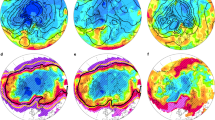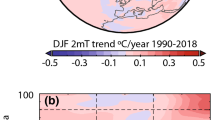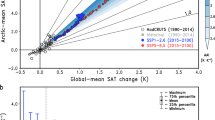Abstract
The Arctic near-surface air temperatures are increasing more than twice as fast as the global average–a feature known as Arctic amplification (AA). A modified AA index is constructed in this paper to emphasize the contrast of warming rate between polar and mid-latitude regions, as well as the spatial and temporal characteristics of AA and their influence on atmospheric circulation over the Northern Hemisphere. Results show that AA has a pronounced annual cycle. The positive or negative phase activities are the strongest in autumn and winter, the weakest in summer. After experiencing a remarkable decadal shift from negative to positive phase in the early global warming hiatus period, the AA has entered into a state of being enlarged continuously, and the decadal regime shift of AA in about 2002 is affected mainly by decadal shift in autumn. In terms of spatial distribution, AA has maximum warming near the surface in almost all seasons except in summer. Poleward of 20°N, AA in autumn has a significant influence on the atmospheric circulation in the following winter. The reason may be that the autumn AA increases the amplitude of planetary waves, slows the wave speeds and weakens upper-level zonal winds through the thermal wind relation, thus influencing surface air temperature in the following winter. The AA correlates to negative phase of the Arctic oscillation (AO) and leads AO by 0–3 months within the period 1979–2002. However, weaker relationship between them is indistinctive after the decadal shift of AA.
Similar content being viewed by others
References
Alexander M A, Bhatt U S, Walsh J E, et al. 2004. The atmospheric response to realistic Arctic sea ice anomalies in an AGCM during winter. J Climate, 17(5): 890–905
Arrhenius S. 1896. On the influence of carbonic acid in the air upon the temperature of the ground. Philos Mag J Sci, 41(251): 237–276
Barnes E A. 2013. Revisiting the evidence linking Arctic amplification to extreme weather in midlatitudes. Geophys Res Lett, 40(17): 4734–4739
Cohen J L, Furtado J C, Barlow M A, et al. 2012. Arctic warming, increasing snow cover and widespread boreal winter cooling. Environ Res Lett, 7(1): 014007
Cohen J, Screen J A, Furtado J C, et al. 2014. Recent Arctic amplification and extreme mid-latitude weather. Nat Geosci, 7(9): 627–637
Cvijanovic I, Caldeira K. 2015. Atmospheric impacts of sea ice decline in CO2 induced global warming. Climate Dyn, 44(5–6): 1173–1186
Davini P. 2013. Atmospheric blocking and winter mid-latitude climate variability [dissertation]. Venice: Università Ca’Foscari Venice
Dee D P, Uppala S M, Simmons A J, et al. 2011. The ERA-Interim reanalysis: configuration and performance of the data assimilation system. Quart J Roy Meteor Soc, 137(656): 553–597
Ding Qinghua, Wallace J M, Battisti D S, et al. 2014. Tropical forcing of the recent rapid Arctic warming in northeastern Canada and Greenland. Nature, 509(7499): 209–212
Francis J A, Vavrus S J. 2012. Evidence linking Arctic amplification to extreme weather in mid-latitudes. Geophys Res Lett, 39(6): L06801
Hopsch S, Cohen J, Dethloff K. 2012. Analysis of a link between fall Arctic sea ice concentration and atmospheric patterns in the following winter. Tellus A, 64(1): 18624
Huang Fei, Di Hui, Hu Beibei, et al. 2014. Decadal regime shift of arctic sea ice and corresponding changes of extreme low temperature. Climate Change Research Letters (in Chinese), 3(2): 39–45
IPCC (Intergovernmental Panel on Climate Change). 2013. Summary for policymakers. In: Stocker T F, Qin D, Plattner G K, et al., eds. Climate Change 2013: the Physical Science Basis. Contribution of Working Group I to the Fifth Assessment Report of the Intergovernmental Panel on Climate Change. United Kingdom, New York, USA: Cambridge University Press
Jaiser R, Dethloff K, Handorf D, et al. 2012. Impact of sea ice cover changes on the Northern Hemisphere atmospheric winter circulation. Tellus A, 64(1): 11595
Ji Fei, Wu Zhaohua, Huang Jianping, et al. 2014. Evolution of land surface air temperature trend. Nat Climate Change, 4(6): 462–466
Juday G P, Barber V, Vaganov E, et al. 2005. Forests, land management, and agriculture. In: Arctic Climate Impact Assessment. Cambridge: Cambridge University Press, 781–862
Kim B M, Son S W, Min S K, et al. 2014. Weakening of the stratospheric polar vortex by Arctic sea-ice loss. Nat Commun, 5: 4646
Mantua N J, Hare S R, Zhang Yuan, et al. 1997. A Pacific interdecadal climate oscillation with impacts on salmon production. Bull Amer Meteor Soc, 78(6): 1069–1079
Masson-Delmotte V, Kageyama M, Braconnot P, et al. 2006. Past and future polar amplification of climate change: climate model intercomparisons and ice-core constraints. Climate Dyn, 26(5): 513–529
Overland J E, Francis J, Hall R, et al. 2015. The melting Arctic and midlatitude weather patterns: are they connected?. J Climate, 28(20): 7917–7932
Overland J E, Wang Muyin. 2010. Large-scale atmospheric circulation changes are associated with the recent loss of Arctic sea ice. Tellus A, 62(1): 1–9
Perlwitz J, Hoerling M, Dole R. 2015. Arctic tropospheric warming: causes and linkages to lower latitudes. J Climate, 28(6): 2154–2167
Screen J A. 2014. Arctic amplification decreases temperature variance in northern mid-to high-latitudes. Nat Climate Change, 4(7): 577–582
Screen J A, Deser C, Simmonds I. 2012. Local and remote controls on observed Arctic warming. Geophys Res Lett, 39(10): L10709
Screen J A, Simmonds I. 2010. The central role of diminishing sea ice in recent Arctic temperature amplification. Nature, 464(7293): 1334–1337
Screen J A, Simmonds I. 2014. Amplified mid-latitude planetary waves favour particular regional weather extremes. Nat Climate Change, 4(8): 704–709
Screen J A, Simmonds I, Deser C, et al. 2013. The atmospheric response to three decades of observed Arctic sea ice loss. J Climate, 26(4): 1230–1248
Serreze M C, Barrett A, Stroeve J, et al. 2009. The emergence of surface-based Arctic amplification. Cryosphere, 3(1): 11–19
Serreze M C, Barry R G. 2011. Processes and impacts of Arctic amplification: a research synthesis. Glob Planet Change, 77(1–2): 85–96
Serreze M C, Carse F, Barry R G, et al. 1997. Icelandic low cyclone activity: climatological features, linkages with the NAO, and relationships with recent changes in the Northern Hemisphere circulation. J Climate, 10(3): 453–464
Serreze M C, Francis J A. 2006. The Arctic amplification debate. Climatic Change, 76(3–4): 241–264
Thompson D W J, Wallace J M. 1998. The Arctic oscillation signature in the wintertime geopotential height and temperature fields. Geophys Res Lett, 25(9): 1297–1300
Wallace J M. 2000. North Atlantic Oscillation/annular mode: two paradigms-one phenomenon. Quart J Roy Meteor Soc, 126(564): 791–805
Wallace J M, Gutzler D S. 1981. Teleconnections in the geopotential height field during the Northern Hemisphere winter. Mon Wea Rev, 109(4): 784–812
Walsh J E. 2014. Intensified warming of the Arctic: causes and impacts on middle latitudes. Glob Planet Change, 117: 52–63
Zhang Xiangdong, Sorteberg A, Zhang Jing, et al. 2008. Recent radical shifts of atmospheric circulations and rapid changes in Arctic climate system. Geophys Res Lett, 35(22): L22701
Author information
Authors and Affiliations
Corresponding author
Additional information
Foundation item: The Global Change Research Program of China under contract No. 2015CB953904; the National Natural Science Foundation of China under contract Nos 41575067 and 41376008.
Rights and permissions
About this article
Cite this article
Wang, Y., Huang, F. & Fan, T. Spatio-temporal variations of Arctic amplification and their linkage with the Arctic oscillation. Acta Oceanol. Sin. 36, 42–51 (2017). https://doi.org/10.1007/s13131-017-1025-z
Received:
Accepted:
Published:
Issue Date:
DOI: https://doi.org/10.1007/s13131-017-1025-z




